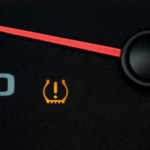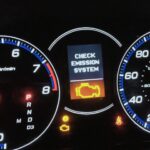You are driving on the highway, and suddenly the tire pressure light on your dashboard turns on. Don’t panic. You’re not going to crash anytime soon. But what does “Check TPMS System” mean?
TPMS is the acronym for Tire Pressure Monitoring System. Your car uses it to warn you if your tire pressure is getting very low. This can cause unsafe driving conditions. If this warning light turns on, one of your tires could be underinflated. This can cause accelerated tire wear and possible tire failure.
If you continue driving your car with the TPMS warning light on, you are taking a risk because it is unsafe to do so. There is no way you can know how much air has already leaked out of your tire. The best thing you can do is to check the tire pressure with a tire pressure gauge. If it’s too low, you must inflate the tire before you continue driving.
Read on to learn more about the TPMS on your car, why it turns on, and how you can fix it so it will turn off.
What Does “Check TPMS System” Mean?

Low Tire Pressure
TPMS is the abbreviation of Tire Pressure Monitoring System. Modern cars flash this message to inform drivers of low tire pressure.
This is your car’s way of telling you that it’s unsafe to drive your car while this light is on. It also means that driving on underinflated tires leads to faster tire wear and, possibly, complete tire failure.
Honda “Check TPMS System” Light
Ordinarily, the TPMS warning light will turn on if the air pressure on your tire becomes considerably low. This is what you can expect in the majority of Honda cars. If this is the brand of your car, its Honda “Check TPMS System” light will turn on when its tire pressure gets too low.
You can turn off this warning light if you want, without checking the tire pressure. Turn the engine off, and then turn the ignition key on. But don’t start the engine. Then hold the TPMS reset button and wait for the tire pressure light to blink three times. Then release it.
Now, start the engine and wait 20 minutes. The tire pressure sensor will restart; hopefully, the TPMS light will not show itself on your dash. In most cars, the TPMS reset button is located underneath the steering wheel.
Designed for Safety
The TPMS light is designed for your safety. So when it is on, it’s unsafe for you to drive your car. Use a tire pressure gauge to check your tire’s current air pressure.
Temperature Change Can Trigger the TPMS
An active TPMS light could also mean a temperature change that caused the change in the tire’s air pressure.
But as soon as the temperature rises, the TPMS light will turn off. This also happens with some Acura “Check TPMS System” lights.
Overinflated Tires or Tire Puncture
Perhaps your tire has just suffered a tire puncture, causing tire pressure loss. Overinflating your tires can also cause the TPMS light to turn on.
The point is that whenever your tires lose air pressure, the TPMS warning light will turn on. And other situations can also trigger this sensor.
Nature of the TPMS Light
Every modern car produced today is equipped with a TPMS warning light. Its primary purpose is to alert the driver that a certain issue has developed in the car’s tires. Ordinarily, this light will turn on if the tire pressure goes below what is safe for driving conditions.
It could mean that a tire is underinflated or overinflated. Whatever the case, improper tire inflation could lead to a faster rate of tire wear and, possibly, a complete tire failure. That’s why you need to know the proper tire pressure that your tires should have.
The TPMS of your car uses a sensor system that monitors the inflation condition of your tires. It can determine whether one or more of your tires are under or over-inflated. If one of these two conditions develops in your tires, the TPMS warning light will flash on your dashboard.
You don’t have to be overly worried when this light flashes on your instrument panel. It doesn’t necessarily mean an expensive trip to your car mechanic.
But don’t ignore it because it warns you about the current condition of your tire. You need to do what is required to turn off the TPMS light.
What Can Cause the TPMS Light to Come on?

Several driving situations can trigger the TPMS light to turn on. Here are the most common of these situations:
1. Malfunctioning TPMS
If the TPMS light flashes for around one minute each time you start your car, then the TPMS itself is malfunctioning. It could mean the system gives you a false reading.
What you can do initially is to check the air pressure on all of your tires. If there’s nothing wrong with your tires, you need to have the TPMS checked by a qualified mechanic as soon as possible.
If the air pressure on your tires is okay, then it’s safe for you to drive. Meanwhile, ignore the TPMS light as you drive. But be sure to check it so you can fix it as early as possible. You must have this warning system every time you are driving your car.
Tire Pressure Sensor Fault [Causes and How to Fix]
2. Abrupt Change in Tire Pressure
If the TPMS turns on and off randomly, one of your tires is nearing its minimum or maximum tire inflation. Tire pressure can increase or decrease, depending on the temperature.
As a result, the air inside the tire can either contract or expand. Either way, the TPMS sensors will be triggered if there is any abrupt change in the tire’s air pressure. Get a tire gauge and check the tire pressure to ensure the tires are in good condition.
You can still drive your car, but remember that the air pressure on your tires will change as you drive. Your car’s handling will be affected by this situation, so be careful.
3. Dangerously Low Tire Pressure
Suppose the TPMS light turns on and stays solid while driving, the air pressure in at least one of your tires is dangerously low. You need to stop your car and park it in a safe place. Then get a tire pressure gauge and check the air pressure on each tire.
If you find a tire with considerably lower air pressure than recommended, inflate it with a portable tire inflator. You should have this tool in your car every time you drive.
You can safely drive your car after inflating the problematic tire. But you need to bring that tire to the tire shop so they can check as to why it is underinflated. Perhaps, it has a puncture that causes the compressed air to leak out. If that’s the case, it needs to be patched.
Low Tire Pressure Light On But Tires Are Fine [Why Is This?]
What to Do If the TPMS Light Turns On
If the TPMS light suddenly turns on you, you should first check each tire’s tire pressure.
Bring a tire pressure gauge with you every time you drive. One of the safest practices you can perform before driving your car each day is to check the air pressure on your tires.
The recommended tire pressure is in the sticker attached to the door jamb. Checking the tire pressure is one of the required daily maintenance you should perform on your car.
However, you now have a situation where the TPMS light on your dash stays solid. After checking the pressure on each tire, you should be able to pinpoint whether the tire is underinflated or overinflated. It is the one triggering the TPMS light on your instrument panel.
Replace that tire with your spare so that you can drive your car safely. Hopefully, the TPMS light will turn off after mounting the spare tire. You must bring your faulty tire to the tire shop for fixing.
Again, what does the check TPMS system mean? The Tire Pressure Monitoring System (TPMS) alerts drivers of low tire pressure. An active TPMS means you have underinflated tires, which can cause tire wear and failure.
How to Fix a TPMS Warning Light

Here are two ways how you can fix an activated TPMS light:
- Fix the TPMS itself
- Fix the problematic tire/s
When inflating an underinflated tire, it is important not to overinflate it. The indicated number on the tire wall is that tire’s recommended maximum inflation level.
It means the maximum air pressure that it can withstand. If you always inflate it at its maximum rating, you can experience a bumpy ride or maybe even a tire blowout.
Tips on Fixing the TPMS Light
Here are several tips that will help you fix the TPMS light whenever it turns on your dash:
1. Observe Whether the TPMS Light Is Flashing or Not
Observe how the TPMS light acts, whether flashing or solidly staring at you. When did it turn on? Was there a considerable change in the temperature in your place recently? You must be keen on these things to know how to approach this problem when it shows itself.
2. Consult a Mechanic
Ask the car mechanic what fix they did to your TPMS light. It’s good to trust your mechanic, but you should still ask them if they have properly replaced or fixed the TPMS sensor/s of your car.
3. Use a Tire Gauge
Don’t just eyeball your tire pressure. It’s not safe to rely on how you see your tires hugging the pavement. The best way to ensure the air pressure on your tires is to use a tire gauge.
You can use a simple tire gauge which you can buy very cheap in any car shop. It is easy to overinflate your tires without a tire pressure gauge.
4. Reset the TPMS Light
If you are sure that all your tires are in good shape and correctly inflated, you can reset the TPMS light on your dashboard. Refer to your car owner’s manual as to how you can reset its TPMS light.
Frequently Asked Questions
This may be the first time you have encountered the term TPMS warning light, so you probably have many questions in your mind that you want to be answered. Perhaps, the answers to your questions are included in this section of my article:
What Does It Mean When My Car Dashboard Says “Check TPMS System”?
When you see these words on your dash, it simply means you need to check the TPMS system of your car. TPMS is just the short word for Tire Pressure Monitoring System.
Generally, it will show up on your dashboard if there’s something wrong with your tires’ air pressure.
Perhaps the sensor of the system detected that one of your tires is dangerously underinflated. An underinflated tire can cause your tire to wear out faster. If this is not corrected, it will lead to total fire failure.
This warning light will also turn on if one of your tires is overinflated. An overinflated tire has a higher risk of a tire blowout. Either of these two conditions will adversely affect the handling of your car.
Is It Safe to Continue Driving with the TPMS Light Turned On?
No, it’s unsafe to continue driving your car if the TPMS light is turned on. You have no way of knowing whether your tires are still able to run or they are already running out of air. Your best option is to stop your car and park it in a safe place.
Then get a tire gauge and check the tire pressure on all the tires. If you find an underinflated one, replace it with your spare tire. And then immediately drive to the nearest tire shop and fix the bad tire.
Can I Fix the TPMS Light on My Dash?
Yes, you can reset the TPMS light on your instrument panel. But before you do that, ensure all your tires are okay. What you can do is turn off the engine first. Then turn the ignition key to the “on” position. But don’t start the engine.
Then hold the TPMS reset button until the TPMS light flashes three times, and then release the button. Now, start the engine and wait 20 minutes. The sensor of the TPMS will refresh itself. In most cars, the TPMS reset button is located underneath the steering wheel.
How Long Can I Drive with the TPMS Light Turned On?
If your tire is not yet terribly underinflated and the air is not leaking out, you could still drive your car safely for about 10 minutes at around 30 miles per hour, even if the TPMS light is turned on.
But you should still inflate your tire properly, as soon as possible, so that the TPMS light will turn off by itself.
Why Is the TPMS Light On When All My Tires Are Good?
If you have checked all your tires and found that they are correctly inflated, there must be a problem with the TPMS light. Perhaps, a sensor in the system is getting faulty readings. Get your car to a qualified mechanic so they can check the sensors of your TPMS.
How Can I Know If the Sensors of My TPMS Are Not Working?
It is easy. Check each tire’s pressure by using a good tire pressure gauge. If your tires are properly inflated, they will show on the pressure gauge.
But if the TPMS says one of your tires is underinflated or overinflated, its reading is incorrect. This indicates that one of the sensors of the TPMS is malfunctioning.
In Closing: “Check TPMS System” – What Does It Mean?
Tire Pressure Monitoring System or TPMS is a warning system your car uses to get your attention if the air pressure inside is below or above the recommended tire pressure. Driving with underinflated or overinflated tires is unsafe.
If this warning light turns on, it could mean the air pressure in one of your tires is too low or too high. This tire condition can lead to accelerated tire wear and a possible failure. The safest thing you can do is check the tire pressure with a tire pressure gauge.
If the pressure is too low for you to drive, you need to inflate the tire first to allow you to drive safely to where you can have the tire fixed. But if the tire is overinflated, release some air until you get the right tire pressure.




![Magnaflow Vs Flowmaster Exhaust System [Which Is Better?] magnaflow vs flowmaster](https://roadsumo.com/wp-content/uploads/2021/05/magnaflow-vs-flowmaster-150x150.jpg)

![Service Stability System [Causes and How to Fix this Warning Light] service stability system](https://roadsumo.com/wp-content/uploads/2022/04/service-stability-system-150x150.jpg)


![Read more about the article Best All-Season Tire for Snow [Top 10 Tires]](https://roadsumo.com/wp-content/uploads/2022/10/best-all-season-tire-for-snow-300x200.jpg)